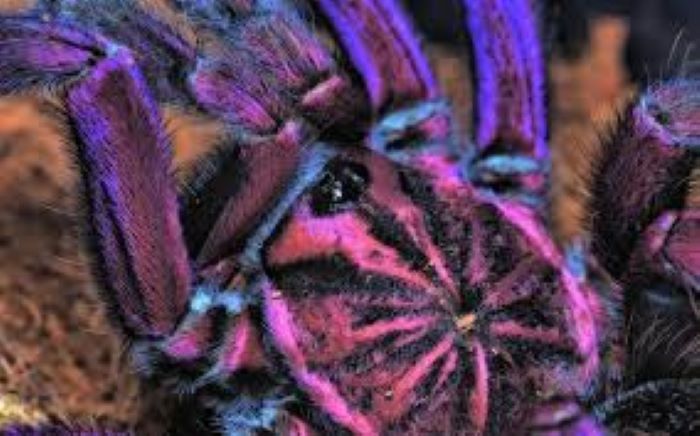The Brazilian pink bloom tarantula (Lasiodora Parahybana) is a giant spider unique to East Brazil’s Atlantic Forest.
The Brazilian Pink bloom tarantula belongs to the Theraphosidae family, also known as the LP or Salmon Pink tarantula. It is claimed to be the third-largest tarantula species in the world. Their large size and willingness for breeding make them desirable as pets.
The ambush predators lurk in the shadows, ready to strike and inject venom to subdue their victim as soon as it approaches.
In general, the males are a little larger than the females. The females are heavier and have a larger abdomen. Its body measures approximately 7 inches long (17.78 cm), with a leg span of 8–10 inches long (20.32 cm – 25.4 cm). They increase, reaching approximately 6 inches (15.24 cm) in length in one year. This spider may grow a diameter of up to six inches in its first year of development.
Their bodies are greyish-black with pinkish-red hair on their legs. Males are brighter in colour, with a more crimson abdomen.
Brazilian pink bloom tarantulas are easily distinguished by their colouring. Still, they also have a characteristic shape: they are hefty, with a pretty large body to their leg length.
When it comes to stature, males have longer legs, whereas females are heavier than males.
There are about 500 to 2000 eggs in the thick silken egg sac. When the eggs hatch, they look round and small.
Spiderlings hatch and scatter shortly after birth.
In contrast to most other spider species, their webs are too small to catch prey effectively.
Tarantulas live on the forest floor in the wild, hidden in leaf litter, logs, caves, or openly. In the Brazilian state of Para ba, the forest floor is their favourite habitat.
They have a limited range of vision. They are barely able to see a few inches in front of them. As a result, their eyes are primarily responsible for distinguishing between light and darkness.
They are characterized by a pair of feelers (known as pedipalps). These organs are responsive to both physical and chemical stimulation.
Tarantulas have another way of interacting with their environment: their bodies are covered in wonderful, sensitive hairs. As a result, they can sense air disturbances generated by insects moving nearby.
Although they occasionally eat a small bird, most of their diet includes various insects. They add lizards, frogs, and mice to the menu.
Many spiders, such as tarantulas, do not use webs to capture their food. Instead, they hide and wait for an opportunity to pounce on an unsuspecting victim. Then, they instantly inject venom into their target to kill it.
Once the victim has been subdued, the eating process begins — and it is not pretty. First, tarantulas expel digesting fluid from their mouths onto their prey. The tarantulas then suck up the partially digested meal through their mouths.
Tarantulas sometimes capture prey before they are ready to consume them. Likewise, there are times when a spider will use its silk to wrap its game before preserving it for another time.
When someone provokes them or makes them attack, they become aggressive. They are very docile. They sting using their hair instead of biting, which can cause skin irritations. On the other hand, their bite is terrible, and their fangs are an inch long. Despite this, its venom is not known to be toxic to humans.
While some tarantulas flick their abdomen to release hairs upon touch, other tarantulas use their hind legs to remove hairs. These urticating hairs are annoying, particularly if they reach predators’ eyes or delicate nasal membranes. Additionally, their coats can cause blindness if they get into one’s eyes.
Brazilian pink bloom tarantulas are solitary creatures that are likely to become violent toward one another if maintained in a terrarium nearby. However, exhibits are sufficiently large to accommodate a tiny population.
Arboreal tarantulas reside in trees, while terrestrial tarantulas live on the ground. Brazilian pink bloom tarantulas live on the floor. They are typically found throughout the day in burrowing or natural hiding spots in the forest. They emerge at night to hunt or mate.
Using his palps, the male spider builds an intricate web on the floor, which is used to deposit sperm before he may absorb it (mouth appendages).
Both sexes use chemical signals in the forest to identify whether other spiders are of the same species and if the female is responsive.
Her front legs will be elevated in a defensive posture, and the male will approach. He releases the sperm through his palps inside a furrow on her abdomen, preventing her from fighting him.
She may store it for approximately three months until she can produce between 500 to 2000 eggs in an egg sac. After that, she will be on the lookout for the spiderlings for several weeks until they hatch.
Pink bloom tarantulas moult approximately ten times every year until they reach full size at around two to 3 years old.
For various reasons, Brazilian pink bloom tarantulas are pretty popular in captivity. Their look, both size and colour, contributes to their desirability. Because they are willing to be out in the open, they are also trendy. Lasiodora Parahybana spiderlings are also more affordable than Theraphosa Blondi since they reproduce many spiderlings.
- “Lasiodora parahybana,” the scientific name for Brazilian pink bloom tarantulas, is also why it’s frequently referred to as “LP.”
- It was found in 1917 by Brazilian biologist Cândido Firmino de Mello-Leito.
- ‘bird-eating spiders’ is another name for Brazilian pink bloom tarantulas, even though there is scant evidence that they regularly prey on birds.
- The pink bloom tarantula’s fangs are 1 inch long and can deliver a painful bite if not handled properly.
- To keep the female from attacking him during the mating process, males have ‘tibial hooks’ protruding from the front of their legs.
- This tarantula’s poison dissolves its prey’s flesh for the spider, making it easier to consume.
- Brazilian pink bloom tarantulas bite only as a last option, but they may defend themselves by flicking barbed hairs from their abdomen. These hairs are highly irritating and can result in blindness.
- Although its numbers are steadily declining in the Atlantic forest, it is not endangered, primarily due to deforestation. The WWF, the Nature Conservancy, and other groups protect the region and various species.
- The Brazilian salmon pink spider is named for its native country. That doesn’t imply you’ll find them everywhere because they’re indigenous to one place.
- They are not aggressive, but they have potentially lethal defence mechanisms.
- They are easy to breed, contributing to their popularity as pets.
The species of Brazilian pink bloom is native to Ecuador and Brazil, wherever it burrows opportunistically in humid regions. Females are dark brown/black, while mature males have a vibrant purple/pink tint; both sexes have characteristic black and orange spiderlings. They are well-known for being extremely defensive.
These intriguing tarantulas are popular among spider enthusiasts, who keep them as pet spiders despite their scary appearance.

Dr. Ananya Singh, the expert behind ThePetster.com, is a dedicated veterinarian with over 9 years of experience in animal health and welfare. She holds a Doctor of Veterinary Medicine (DVM) degree. Dr. Singh specializes in comprehensive pet care, preventative health, and holistic wellness. Follow her on Instagram for expert advice and updates.
